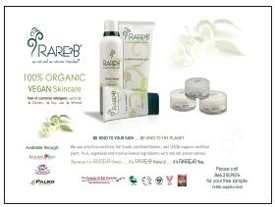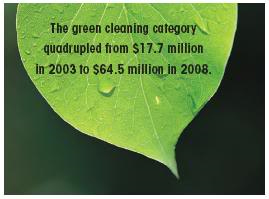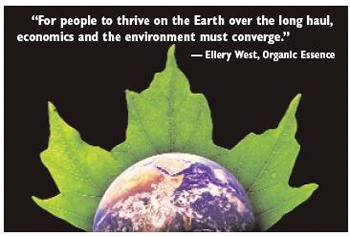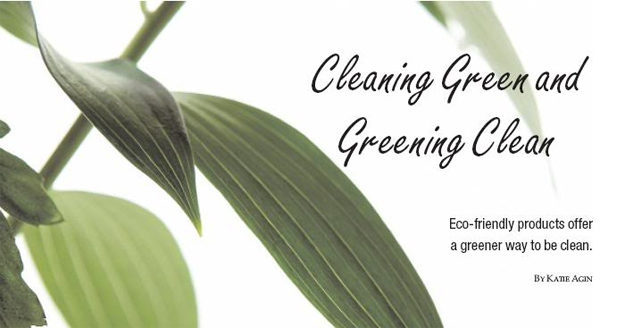You treasure your family and friends. You are helpful and friendly even to strangers. But, let’s be honest. Being green is the new trendy way to be a friend—the slew of eco-friendly cleaning, kitchen and bathroom products on the market prove it. According to the Mintel report Environmentally Friendly Cleaning Products, US, January 2009 Market Size and Forecast, the green cleaning category quadrupled from $17.7 million in 2003 to $64.5 million in 2008.
New, creative products remind us that environmental care starts right in our homes, in the tiny worlds around us, not necessarily out in the rainforest or in the depths of the ocean. As a reflection of this, Greg Cumberford, vice president of strategic initiatives for Gaia Herbs, Inc., Brevard, NC, realizes that “the phenomenon is worldwide and personal at once.”
Taking small steps at home, choosing the right products and supporting companies that are environmentally and socially responsible can make a world of difference.
What Does Green Really Mean?
Often identified as an anti-mainstream cause in previous years, environmentalism has become the latest and greatest trend. According to Ron Darcey, marketing and advertising consultant for Static Eliminator maker Maddocks Holdings, Ltd., Ontario, Canada and natural drain cleaner maker Drainbo, Livermore, CA, “Green is becoming a national and dedicated activity across the country” and is “here to stay.” Although many companies really are committed to helping the environment, problems arise when unethical firms try to bank on this latest trend by exploiting those with genuinely eco-friendly intentions—retailers and consumers.
 Marketing. Gimmicks can often get the best of us, especially when it comes to making decisions that will benefit our health, our homes and our planet. People feel good contributing to the cause and will naturally gravitate toward products that claim to be eco-friendly—whether they are or not. Too often, good intentions are preyed upon and companies are unable to support their claims of eco-friendliness.
Marketing. Gimmicks can often get the best of us, especially when it comes to making decisions that will benefit our health, our homes and our planet. People feel good contributing to the cause and will naturally gravitate toward products that claim to be eco-friendly—whether they are or not. Too often, good intentions are preyed upon and companies are unable to support their claims of eco-friendliness.
But John Murphy, senior vice president of sales at Seventh Generation, Burlington, VT, believes consumers are catching on. He notes how parents, especially new moms, are “particularly savvy in their approach to buying and sophisticated in their knowledge and expertise relative to real green versus green-washing.” Seventh Generation carries a line of eco-friendly products for the kitchen, laundry and bathroom, as well as baby products and chlorine-free feminine care products.
Indeed, education is key to ensuring that eco-friendly products end up on store shelves and in consumers’ shopping bags (reusable, we hope). According to Cumberford, the best ways to differentiate truly green products from green-washed products is to discern if:
- they are made entirely from natural/certified organic components,
- their manufacturing process does not involve any synthetic/petroleum chemistry or genetically modified organisms,
- they were made or composed of fair trade-sourced materials, and
- their consumption results in either a fully recyclable waste product or a fully biodegradable one.
“Most products will not score perfectly by each of these four core criteria, but these provide a way to score the extent to which their consumption contributes to a more sustainable, earth-friendly supply chain,” says Murphy.
 Labeling. Without conducting their own extensive research, consumers must rely on product packaging as their only indication of eco-friendliness, with labels ranging from true and helpful, to tricky and even false. Seema Maloni, vice president of marketing for Oasis Bags, Vaudreuil-Dorion, Quebec, Canada says there are certifications, specifically from third-party environmental performance labeling organizations, that green companies can acquire to differentiate themselves from those who green-wash.
Labeling. Without conducting their own extensive research, consumers must rely on product packaging as their only indication of eco-friendliness, with labels ranging from true and helpful, to tricky and even false. Seema Maloni, vice president of marketing for Oasis Bags, Vaudreuil-Dorion, Quebec, Canada says there are certifications, specifically from third-party environmental performance labeling organizations, that green companies can acquire to differentiate themselves from those who green-wash.
This, however, may not always be enough to show a clear picture of where a product or company stands environmentally. Ellery West, president of Crescent City, CA-based Organic Essence, maker of eco-friendly creams, lip balms and soaps, notes an abundance of products bearing a label indicating it was made with sustainable electricity. “This certainly qualifies as green,” he comments, “but in a very limited way because it addresses only a small part of a product’s overall footprint.” Other factors include ingredients, packaging and transport.
It’s true; labels and marketing can trick consumers…but they can fool retailers too. In an ideal world, manufacturers and suppliers would be responsible. But the brunt of the work often is on the shoulders of retailers to research products before they are brought into the store by looking at ingredients and packaging in addition to the manufacturer’s philosophies and policies. According to Murphy, full ingredient disclosure is key: “If a company or brand is not willing to tell you everything that’s inside and be totally transparent in terms of ingredients, they probably have something to hide.”
Robin Levine, president of Eco-Me, LLC, Pasadena, CA agrees, advising that sometimes chemicals are not listed or are hidden under terms such as “fragrance” or “preservative.” She cautions retailers and consumers: “Just because a product uses plant-based ingredients and some essential oils does not mean it is without other harmful ingredients. Being a vinegar-based product line helps Eco-Me products kill up to 98% bacteria, eliminate odors and dirt, and clean without harming your health, the environment or your home. Funny how the basics are what work the best.”
Cleaning Up. On a positive note, many companies are updating their policies and realizing that we’re all in this together. Lisa Foster, president and founder of 1 Bag at a Time, Inc., believes “social and environmental exploitation for corporate profit are becoming obsolete. People are looking to restructure and invest in our future, to put long-term goals first over short-term gains.” Even so, retailers should be careful and always have the right to demand relevant information from both emerging and established brands, emphasizes Wes McMahon, marketing manager for ChicoBag Company, Chico, CA.
However, hesitancy on the part of retailers to bring in new eco-friendly products can also be detrimental to sales and halt the momentum of shoppers to participate in the eco-friendly movement. Darcey often receives calls from consumers about products that have been seen in advertisements, but are not in stores. He says, “Unfortunately, many fine natural products fail because of this lengthy and costly review and acceptance process. This becomes the fault not of consumer awareness, but one of product availability.”
But consumers still carry some responsibility as well. Says McMahon, “Vendors can put all their energy into a sustainable development model, but if the end user does not focus on reducing their consumption of disposable products and reintegrating their waste into the manufacturing process, then we have not reached our full potential in reducing the net impact to the environment.” For the most part, consumers know they want safe, eco-friendly, effective and cost-efficient products and rely heavily on the retailer to deliver trustworthy products.
 Murphy says, “There is unprecedented consumer interest in the green and sustainable home care segment.” He also recalls a major U.S. retailer telling him that “green and sustainability are now the cost of entry to even participate in the home care category.” He advises retailers to “be proactive and leverage the full might of your merchandising prowess to reveal these opportunities in your stores.”
Murphy says, “There is unprecedented consumer interest in the green and sustainable home care segment.” He also recalls a major U.S. retailer telling him that “green and sustainability are now the cost of entry to even participate in the home care category.” He advises retailers to “be proactive and leverage the full might of your merchandising prowess to reveal these opportunities in your stores.”
But too often “retailers and distributors alike are talking the talk (of their concern about the environment and interested in providing more all natural products), but unfortunately not walking the walk,” notes Darcey. In the month of April (Earth Day on April 22!), retailers have a lot opportunity to focus activities in their stores around eco-friendly issues. Retailers can introduce new green initiatives within their stores, such as a reusable bag policy, interactive activities for customers and staff, a community green day and so on.
Sharing his enthusiasm about being pro- and interactive, Scott Radcliffe, vice president of marketing of reusable bottle maker SIGG, Stamford, CT, says, “Inviting customers to participate in a dialogue allows issues to become front and center in daily life.” Talk to customers, find out what they want and what questions they have about products and your store’s policies—and then adjust if you need to!
Reuse it or lose it. Adjusting your store’s bag policy can be the simplest way to quickly make a difference. Reusable bags are quickly becoming the standard for even conventional stores, so all natural products retailers would do well to hop aboard this bandwagon. Foster says, “Choosing reusable bags over disposable bags can reduce waste and emission significantly and help keep city budgets from going to waste—literally.”
Most companies will personalize their reusable bags by placing store logos on their products to create a strong eco-friendly image for retail stores, as well as encouraging customer loyalty.
Exposed! Under the Kitchen Sink
Lurking in the depths of the cabinet under our kitchen sinks is a danger that we all know exists, but often ignore. Unfortunately, the toxic chemicals in conventional household products can be more detrimental than helpful. When cleaning products are used indoors, especially without ventilation, people can be exposed to levels of airborne chemicals that can become toxic, which can worsen when they are mixed together.
According to data from the Environmental Protection Agency referenced by Cindy Rimer, vice president of sales and marketing for Biokleen, Vancouver,WA, the air inside a typical home is two to fives more polluted than the air outside, mainly due to household chemicals and pesticides. “Asthma, along with skin conditions, are on the rise as well as millions of consumers with chemical sensitivities and allergies,” says Rimer. As a solution, Biokleen offers a full line of natural household, kitchen and laundry products promised to be environmentally safe and non-toxic.
Justine Lopez, marketing coordinator for vegetable-based cleaner maker Howard Products, Paso Robles, CA, agrees, noting, “Consumers with allergies or asthma are especially the ones who benefit from new choices in natural products” and formulations with fewer and less irritating ingredients.
In addition to airborne toxins, chemicals in products used to clean various surfaces in our homes, along with dishwashing and laundry products, often leave behind residues that can pollute our bodies by ingestion or through the skin. According to Kelly Vlahakis, vice president of media relations at Earth Friendly Products, Winnetka, IL, “Standard laundry detergents contain petroleum derived surfactants, which are suspected human carcinogens, phosphates, 1,4-dioxane, formaldehyde and other toxic ingredients.” As a solution, Earth Friendly Products offers 150 non-toxic, eco-friendly household products.
Although acute health issues from conventional products such as stinging in your eye from a splash of soap or feeling dizzy from cleaning fumes are obvious, the long-term effects of these products are of greater concern. Some examples include decreased sense of smell, respiratory trouble, skin and eye damage, and gastrointestinal complications.
Even after we are finished with these products, they still remain dangerous as they move on to harm the environment. Levine says, “Cleaning products and personal care products go right down the drain after use. There are products such as soaps, dishwasher and laundry products that have petrochemicals and these chemicals destroy our water systems by causing overgrowth in algae. These chemicals cause reproductive issues in our fish which, in turn, end up in our food. There is a circle of use we all must pay attention to—it all comes back around.”
Levine advises that your entire body, home and pets can be cleaned with basic ingredients found right in your kitchen, including: distilled white vinegar, baking powder and soda, olive oil, sugar and pure plant essential oils. Eco-Me products are available in kits so customers can mix their own products, ensuring safety, offering piece of mind and a bit of eco-friendly fun, too.
Thinking Outside the Cardboard Box
In addition to what’s inside products, retailers and consumers should also be concerned about what’s around them. Packaging has become a very hot topic in the market. It seems that everyone in the industry wants more products, less packaging, higher quality, lower amounts of waste—and for good reason, too. Landfills not only take up valuable square footage on our planet, but also cause various dangerous side effects such as methane production and groundwater contamination.
Today, there are so many alternatives to big, bulky, wasteful and non-recyclable packaging. For example, biodegradable packaging is becoming a popular option.Says West of Organic Essence, “The biodegradable jar performs just as well as plastic, but is made out of paper—even the label is biodegradable.”
Brian Ross, CEO of TWIST, Boulder, CO, agrees. “For example,” he says, “At TWIST, all of our products are 100% biodegradable. If something is biodegradable and compostable, you can be more certain that it is made from more earth-friendly materials versus more toxic, non-biodegradable materials.”
Plantic Technologies Limited, Andover, MA offers another solution. The company makes materials from patented high amylase corn starch that is non-genetically modified—a product that is completely biodegradable, water dispersable, home compostable and compostable to European (EN13432) and American (ASTM6400) standards. Brendan Morris, C.E.O. of Plantic, indicates that “every ton of Plantic material used in place of petrochemical polymers saves an average of two tons of carbon dioxide (equivalent to the average annual emissions of a compact car).”
 Green for Green
Green for Green
Considering the current economic climate, many consumers may have reservations about paying extra money to keep eco-friendly products in their homes when keeping money in their wallets seems like so much more of a pressing issue. It is a common misconception that those who choose to be responsible must pay for it monetarily. Most of the time, prices for natural products are not much higher, but the value of the product certainly is. Moreover, if the cost of a product is exceedingly low, consumers should wonder why. According to Foster, “If the price looks too good to be true, it probably is. Most deep cost-cutting measures hurt our environment or exploit people.”
With less impact on our long-term health, sustainability and efficiency, it seems that natural products are the obvious choice for being environmentally and economically responsible.
Consumers often get more for their money with natural products. “Biokleen has been formulating and producing 3x concentrated products for 20 years in several segments: laundry, dish and cleaners,” says Rimer.
Concentrated formulas not only save consumers money initially, but also save the entire supply chain a few dollars more on transport and packaging costs later.
Ross notes that the TWIST Loofah Sponge will often last three to four times longer and one sponge will replace 17 rolls of paper towels.
Many retail stores across the country will give customers credit for bringing reusable bags, says McMahon of ChicoBag. Some municipalities may even charge customers for using disposable bags. To help consumers feel as comfortable as possible with spending their already stretched dollars, Radcliffe believes “it is incumbent upon companies to communicate the economical message just as much as the ecological message” and how the two are very much symbiotic ideas.
West agrees, saying, “It’s important to differentiate between short-term gain and long-term costs. When you buy something that is truly eco-friendly, the upfront cost may be a little higher, but the ultimate cost is a bargain.” WF
Published in WholeFoods Magazine, April 2009









